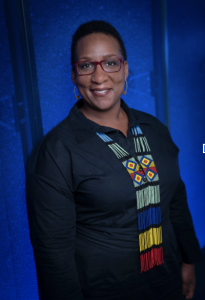We are celebrating Women in STEM this Women’s History Month. Dr. Rabiah Mayas shared her STEM story and how her experience fuels her work.
 Tell us about your background.
Tell us about your background.
I was a Meyerhoff Scholar at the University of Maryland Baltimore County (UMBC), and through that program, I was prepared and mentored toward pursuing a Ph.D. in STEM. I attended the University of Chicago for my graduate degrees and really enjoyed my research; the discovery of new molecular pathways in our cells and the collaborative nature of our lab helped make the grueling Ph.D. an overall positive experience for me. In thinking about what to do after grad school, I knew pretty early on that I wanted to find a career in which I could help young people get excited about STEM, especially children who didn’t have the kind of opportunities I was given growing up. By the time I defended my dissertation, I still didn’t have a strong sense of where I was going next, so it was fortuitous that I learned about an opening at the Museum of Science and Industry, Chicago (MSI) to support a yearlong science festival called Science Chicago. The project was a crash course in all things public engagement and it was fun, exhausting, and a huge learning experience that definitely got me hooked. I was offered a permanent role at the Museum and stayed for nine years, leading several education programs and projects both inside and outside the Museum. I left MSI in 2017 to explore a new opportunity at Northwestern University and returned to MSI in 2019 in my current role.
How has your previous experience shaped you as a professional?
While I haven’t conducted scientific research in 12 years, my experience in an academic lab taught me some critical skills in troubleshooting problems, proposal and report writing, project management, and researching new areas. A challenge of this work is the need to be more of a generalist; graduate work teaches you how to be an expert in a very focused area, but my role demands understanding and proficiency in a variety of areas. And many of those areas are outside of what I learned from 11 years of learning and doing biochemistry and molecular biology, but they are also some of the things I like most as a professional: people leadership, conflict resolution, and community engagement, to name a few. So it’s those areas where I’ve spent a lot of time reading, taking courses, talking with mentors, and learning from my teams so I can support them in the ways they need.
What have been some challenges you or other women you are familiar with face in the workforce?
Despite the significant advances toward gender inclusion in the STEM workforce, there are still pervasive messages – active and passive – telling girls, women, BIPOC what they are not capable of and what spaces and fields are not for them. I have found that it sometimes still takes some extra work to remember that I have earned the right to hold a particular position, lead an initiative, be invited to speak or be trusted with institutional resources. I also have had to learn how to manage others’ stereotypical misperceptions of me as a woman, Black woman, and trained scientist, and a mentor reminds me often that others’ perceptions are neither my responsibility nor my reality. I’m incredibly fortunate to work in a supportive environment in which many of my colleagues are women and I believe part of my responsibility – which I welcome fully – is to make this path less burdensome for those who are at earlier stages of their careers.
What advice do you have for girls exploring the STEM fields?
It might sound simple, but my core advice would be: “try it”. The curiosity of young people is like no other and it’s one of the most exciting things to witness and nurture as an educator. Exploring an interest and seeing what you enjoy (and, importantly, what you don’t enjoy) is a critical part of the origin story of so many people in STEM, including women. So I’d recommend trying out that game, taking the class, doing the hands-on activity, watching the video, picking up the STEM tool…exploring what piques your interest, and being open to where it takes you. My other core advice would be to find your crew – at every stage of life, it’s critical to have people around you who connect with what you care about. I think we understand this well about friendships, but it can also be really important around STEM. Having peers who share an interest in STEM can provide a buddy to explore something new, a study and accountability partner, and even a peer mentor. Some of my best friends of 20+ years were first my STEM study partners and classmates, and those relationships were a critical part of my support system throughout college, graduate school, and through today.
It’s 2050 and we are living in a more equitable world where the underrepresentation of girls in STEM is no more, describe what that looks like or the kinds of things that have happened to get us there.
I think a more equitable world in this context would be one in which the systems that center maleness, whiteness, and western-ness in STEM have been disrupted in such a way that people who don’t identify with those norms are fully included in STEM. This would include pathways into STEM more deeply grounded in collaboration, jobs that normalize family care for all genders, strong mentorship models for students and early-career professionals. and public accountability metrics for academic, corporate, and non-profit institutions for upholding gender equity and gender inclusion.
